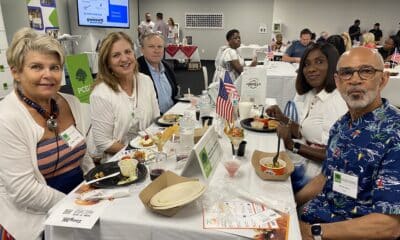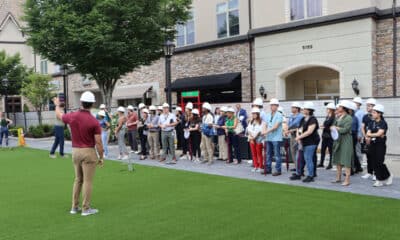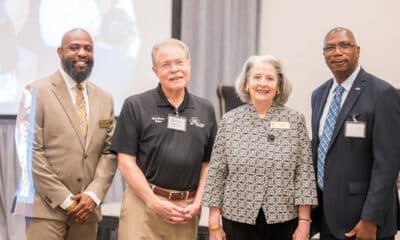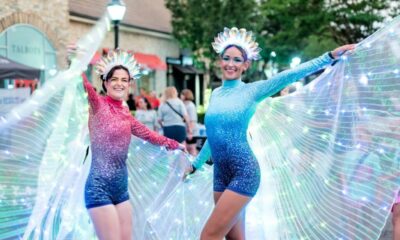Arts & Literature
Jennifer Keim Loves to Play & Explore the Beauty of Exotic Animals through Art
Published
1 year agoon
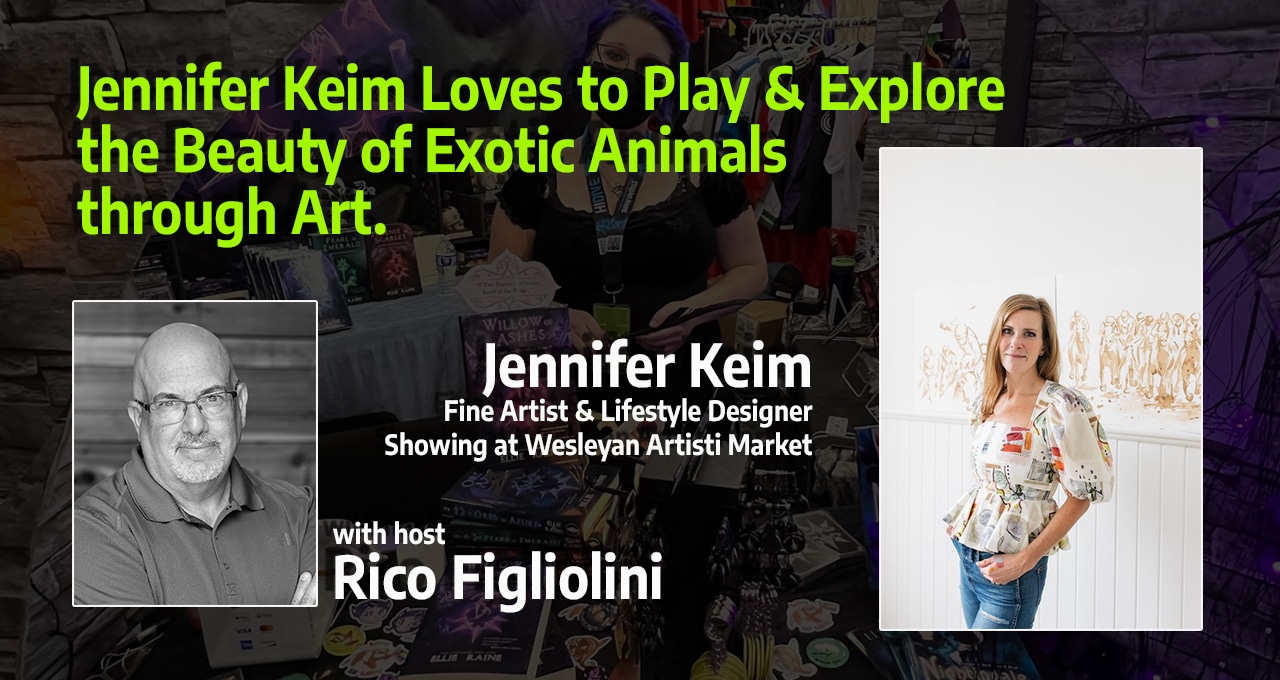
The Wesleyan Artist Market is back and celebrating its 25th year. On this special episode of Peachtree Corners Life, Rico Figliolini is joined by artist Jennifer Keim, one of the many artists featured at the Wesleyan Artist Market 2023. Jennifer shares her story, her inspiration, and a behind-the-scenes look into her creative process.
Resources:
Jennifer’s Website: https://www.jkeim.com
Jennifer’s Social Media: @JKeimStudio
Wesleyan Artist Market: artistmarket.wesleyanschool.org
“Already having an intrigue for the animals, wanting to be an exotic vet, and save the lions and tigers. I was already drawn to the massiveness. I just find them so beautiful and just so intriguing… I find that even if I’m in a rut, like what’s my next move? What’s my next series like? What do I want to do? Do I even want to do art anymore? In my moments of, oh, woe is me, I find that I just go back to the animals to help me break out of that rut.”
Jennifer Keim
Timestamp:
[00:00:30] – Intro
[00:02:20] – About Jennifer
[00:04:36] – Preferred Mediums
[00:12:53] – Using Wildlife and Travel Experiences
[00:16:55] – Creating Daily
[00:18:15] – Capturing a Moment
[00:20:13] – The Fly Guys Series
[00:24:39] – Textile Art
[00:28:11] – Jennifer’s Art at the Wesleyan Artist Market
[00:30:15] – Closing


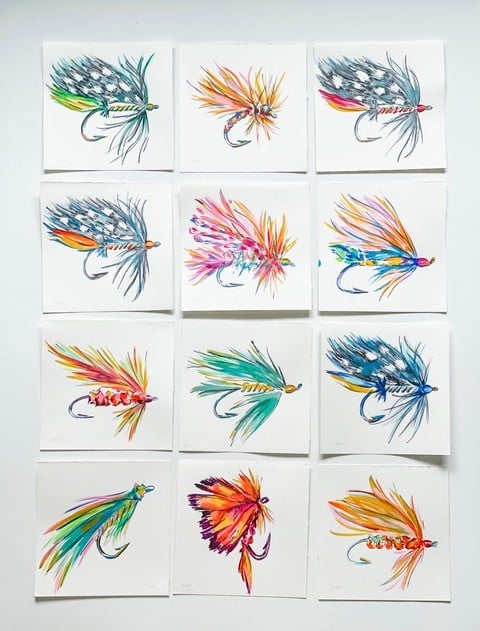
Podcast Transcript
[00:00:30] Rico: Hi everyone, this is Rico Figliolini, host of Peachtree Corners Life. I do want to introduce you to our show and our special guest today, all the way from Hawaii. Jennifer Keim. Hey Jennifer. Thanks for joining us.
[00:00:41] Jennifer: Hi. Happy to be here. Thank you for having me.
[00:00:45] Rico: Cool. I heard you were on the waters on the ocean before. Everything okay? Took some Go Pros?
[00:00:49] Jennifer: No, it’s just gorgeous.
[00:00:53] Rico: Sure.
[00:00:53] Jennifer: It is gorgeous. The whales are active. And I had the chance going yesterday to an out rigger where we paddle out and we’re just right there with the whales, so.
[00:01:04] Rico: That’s amazing. Yeah, and we’ll get into some of that. I mean, some of your artwork is animal related. So we’ll talk about that inspiration. But before we get there, let me just introduce our sponsor for the podcast and our corporate sponsor for everything that we do. And that’s EV Remodeling. Eli from EV Remodeling lives here, right here in Peachtree Corners. Great guy. He was just featured in one of our issues recently. He does home renovation, remodeling, from design to build. Just a great guy, great family. Check them out. EVRemodelingInc.com is where he’s at. So check him out and let’s just get right into it. Hey, Jennifer.
[00:01:39] Jennifer: Okay, great.
[00:01:40] Rico: So you’re, we’re gonna call you, I mean, I’ve checked through it, done my research a little bit, so I have some stuff about you. It’s amazing what’s on the net. You’re a fine artist and lifestyle designer.
[00:01:52] Jennifer: Yes.
[00:01:52] Rico: A global design brand. In fact, the reason that we’re interviewing you is because you’re going to be one of 75 artists being showcased at the Wesleyan Artist Market here in Peachtree Corners April 28th and 29th. So I’m glad that you’re gonna be there. And you’re gonna be actually one of the three artists that we’re featuring in our print magazine in the upcoming issue. It’s just fantastic. But I want to know a little bit more about you. What makes the artist Jennifer Keim? So tell us a little bit about yourself.
[00:02:20] Jennifer: A little bit about myself. Well, there’s a lot.
[00:02:24] Rico: I’m sure.
[00:02:24] Jennifer: And lots of layers, but really it all started fourth grade. My parents were really good about having me try new things and see what my niche was. And so they put me in an art camp. And I’m from Columbus, Georgia. And they put me in an art camp at the museum for a week long. And the instructor said she has something, Jill Chancey Phillips. And she from there on, she’s like, keep her in it. She needs to be in the art world and I can give her private lessons. And so I had private lessons with her all the way through until I went off to school. So she was my mentor and I mean she is my special, so.
[00:03:03] Rico: Wow. And interestingly enough, I mean, you’re displayed in the museums and galleries all over the country. You’ve been on, featured on HGTV as well. You were also at Columbus museum, right? How old were you when your art was exhibited there?
[00:03:18] Jennifer: Well, I mean, I was very young, actually. And yeah, very young. And then there was a moment in high school as well, so, for one of the little exhibits. It feels so long ago though, a lot’s happened since then.
[00:03:34] Rico: I’m sure. What about HGTV? How did that come about? How were you featured there?
[00:03:39] Jennifer: Well, I was actually featured twice. Once there was an interior designer in Atlanta and she commissioned me to do a piece to go in her theater room. And I can’t even pull up in my head what year that was. I think it was probably 2007. And then my most recent one, my Protea, which is one contour line paintings. It’s one continuous line without lifting your pen, were featured through a designer for the Bargain Mansion Show with Tamara Day.
[00:04:13] Rico: Cool. It’s great exposure, I’m sure. The artwork that you’ve done, I mean, the mediums that you work in, there’s several different mediums it sounds like that you work in. Watercolor, you work in textiles, you do canvas work, oils, pastels. How do you come about choosing, or what do you feel most comfortable in expressing your inner artist? What type of medium do you like best?
[00:04:36] Jennifer: That’s a really good question because I feel like every medium has their own personality. So you’ve got your drawing technique that’s, you know, you can do quick gestural, And then you have your painting where you can just layer, layer, layer. So there’s just so many different personalities that happen when you’ve got the different mediums. And a lot of times it’s just the subject kind of craves a certain medium. So, you’ve got your line drawing and certain subjects, like the contour line paintings that I do, like just to have the simple shapes of the subject versus really getting into the layered paint of like a floral, like a mountain view. They each all have different personalities that you kind of play off of. But one of my main reasons too where I jump around, like I’ll play in oils for a while. And I mean, I’m a messy one, so like it’s all, it’s in my ear. It’s all over. And I try to keep it as clean as possible, but it just kind of happens. With the oils, you know, I love to use the pallet knife and work with the coastal scenes and see the layer of the marsh. And just kind of play off of that. But the oils and pastels after a while, and I didn’t realize this until it just kind of happened, it was a buildup of episodes that were happening with my body that I became, I realized I was, my body was toxic from playing and being in all the oils and pastels for a long while.
[00:05:57] Rico: Oh, wow.
[00:05:57] Jennifer: So I would work then I, it took a year to kind of clean up and not have any more of my episodes. Where then it just connected, what was the issue that I, there was just a common ground of the toxins. And I had to then be more aware of my surroundings and how I actually use these materials safely. So the awareness of using these subjects, or these mediums. I’m better now about keeping it safe.
[00:06:25] Rico: That’s a bit horrible if it’s like someone that loves cats, but is allergic.
[00:06:29] Jennifer: They’re allergic, yeah.
[00:06:31] Rico: That would be just bad, right? I can’t imagine that.
[00:06:33] Jennifer: Well, I have this really, really nice air purifier now, and I make, I wear gloves when I, and when I’m in the oils just to help one less thing to kind of get into my system.
[00:06:45] Rico: Sure, sure. So when you’re doing a piece, because you do series of pieces. And we’ll show a couple of these things. Has it happened when you started in a medium and then you decided that’s not the right medium and you shift and use it different? Or does it, once you decide watercolor?
[00:07:02] Jennifer: I’m always playing and exploring and I feel like if you’re not, if you’re not doing that and you’re not challenging yourself, then you’re stuck. But I always like to explore. I work with my off to the races too, and then some of my animal series with gouache. So that’s just, that’s basically like an acrylic and a watercolor, if they had a baby, it would be gouache. So you have the opaqueness, but then the transparency that can happen with watercolor, but the opaqueness of an acrylic, that’s gouache. Yeah, that’s gouache for you, yes.
[00:07:33] Rico: So tell us about the lion.
[00:07:35] Jennifer: Yes. Yes. And that’s all about just layering of color. There’s lots of layers.
[00:07:41] Rico: Was this a sketch or was this a final piece?
[00:07:44] Jennifer: This is a final piece.
[00:07:45] Rico: Okay.
[00:07:46] Jennifer: And so I start off with like that neutral color to draw it out. And there’s nothing forgiving about a water gouache piece. I mean, once you put a stroke down, it’s there. There’s no way of lifting or recovering from it. So, I always start with the eyes, because I feel like you’ve got to land the eyes or the piece won’t be as impactful. And then I’ll put down the base coat, walk away, maybe start another piece until the other one’s dry and start playing at the color.
[00:08:17] Rico: So is it the same techniques that you’re using, that you use here as well?
[00:08:22] Jennifer: So that’s the interesting part. The lion was a gouache and now we’re looking at the ostriches, and that’s my pastel on wood panel. And this is a drawing medium versus the lion is a painting medium. And so with this, this is one of my favorite techniques right now because it’s the vulnerability that happens with the whole process, I am dependent on how the resin reacts to the wood and the pastel. And my whole climate’s got to be good, dust-free environment. I draw it on first with the pastel. Also pastel, once it’s touched the wood, like not forgiving, like I’ve tried to lift it up. But because of the really deep blues, those always will, you’ll see like a ghost line if I had to erase. But I’ll do the pastel and then I will pour the resin in. And I don’t know if anyone’s familiar with resin, but you mix these two concoctions, stir, you mix for three minutes. And then you pour it onto the pastel resin or a pastel board. And I have 15 minutes to relieve the bubbles, and then I have to walk away for three days.
[00:09:32] Rico: Wow.
[00:09:32] Jennifer: And then the resin, the chemistry that happens most of the time, like I’ve finished drawing the ostrich’s with my pastel, and most people would be like, that’s a finished piece. And it is for, in that case, but for my process, that’s halfway through. So my next step is the resin which could change the whole game of this piece. It could make or break it basically.
[00:09:58] Rico: It sounds similar to, I interviewed last year, I think it was an artist that works at pottery, right? And glazing and using kilns and stuff to fire up. And it’s similar to that. They could be using a color that looks blue. And then once you’ve done the process and you’re, you have to really be careful when you’re baking, if you will, that you stop it. Completely stop the oxygen from allowing further the work because the colors will shift to completely different colors.
[00:10:25] Jennifer: I know. It’s so, it’s crazy. It is so crazy. And you have to level the board out too, where, I mean this, but I’ve been working with resin for 21 years. So I’ve learned and I’ve learned and I’ve learned. And every, because I used to build my boards, but now I actually have them built for me and do this nice beveled edge, that just kind of shows through once the resin is poured. But you learn these things. Like I have to make sure it’s really level because if it’s shifted somehow, the pastel that basically melts with the resin will then kind of just bleed through and then it’ll just move down in the direction of the gravity. So I’ve got to learn to manipulate that and make sure it stays up to where it’s not spilling off to the bottom of the panel.
[00:11:10] Rico: Wow. I can’t even imagine. You spend the time creating it and then you put the resin on and God forbid something big goes.
[00:11:17] Jennifer: I know. Yeah.
[00:11:18] Rico: You just throw it out and just start again?
[00:11:21] Jennifer: Yes. And there was my most recent pour, I did my largest pour in my whole career. Eight gallons of resin.
[00:11:28] Rico: Oh my God.
[00:11:29] Jennifer: And 13 pieces. And I always like to kind of challenge myself too. But I could have gotten myself in trouble, but.
[00:11:35] Rico: It all turned out okay?
[00:11:36] Jennifer: It did. I poured it and it turned out great. But there was one panel that was giving me a fit. And the bubbles just kind of kept coming up and up and up and up. And it was almost like it was just drink ing. The wood was drinking the resin, the way that it just pushing out all the air and oxygen and everything from it.
[00:11:54] Rico: Wow.
[00:11:54] Jennifer: I finally got it to work, but it gave me a fit. So there’s always, always, it’s something’s gonna happen.
[00:12:02] Rico: Yeah, it almost sounds like you have to heat up the wood or do something to the wood to prep it before you do the water.
[00:12:08] Jennifer: Well, it needs to be like regulated with the temperature.
[00:12:11] Rico: Okay.
[00:12:11] Jennifer: And the humidity’s got to be just right for it to dry and not get tacky.
[00:12:18] Rico: I’m sure.
[00:12:18] Jennifer: And no kids or dogs or cats or husbands could come around after. Like right after the pour, so.
[00:12:25] Rico: Yes. How old are your kids now?
[00:12:27] Jennifer: My daughter, Jane, is 10.
[00:12:29] Rico: Okay.
[00:12:30] Jennifer: And she’s in fifth grade. And then my son, Charlie, is six, in kindergarten.
[00:12:35] Rico: Alright. Old enough to know not to put their hands on the artwork as it’s seemed curing.
[00:12:39] Jennifer: Well, they know mommy’s pouring. Like when the big sign says, do not open.
[00:12:43] Rico: Okay, alright. That’s like my handwritten sign on the door. It says podcast recording.
[00:12:50] Jennifer: Yes, yes.
[00:12:52] Rico: It’s funny. Just to back step just a little bit, when you started wanting to become an artist in fourth grade or four years old. You did do that double major as a vet and art. I guess you wanted to become a veterinarian at some point, but microbiology wasn’t working for you, I guess.
[00:13:09] Jennifer: Yeah.
[00:13:10] Rico: But animals seem to inform a lot of the stuff you do, or at least wildlife does. And I know that at one point, for example, you went to South Africa where the exotic animals are. Did that inform any of the other work that you’ve done? I mean, how do you, how do you use trips like that? Like that or like Hawaii where you see the big whales in the ocean?
[00:13:31] Jennifer: Yes.
[00:13:32] Rico: How do you use that?
[00:13:33] Jennifer: Oh man. Well, so already having an intrigue for the animals, wanting to be an exotic vet, save the lions and tigers. I was already drawn to the, just the massiveness and just the larger, I mean, these guys are just, I just find ’em so beautiful and just so intriguing, being so large. But then going to South Africa and seeing them like right there how their circle of life works. And then seeing how much bigger they really are in person, right on their trek to go kill the water buffalo and all the things. It, I get chills. Like it just, it lights my fire. I mean, it livens me up. And I find that even if I’m in a rut, like what’s my next, what’s my next move? What’s my next series like? What do I want to do? Do I even want to do art anymore? Like when I’m in my, like, my moments of, oh, woe is me. Like, what do I do with myself? I find that I just go back to the animals to help me break out of that rut, if you call it.
[00:14:30] Rico: Okay. cool.
[00:14:31] Jennifer: But they just, they just make my heartbeat differently.
[00:14:34] Rico: I would think that seeing, I’ve been to Cairo some years back and seeing the pyramids, seeing the sphinx, way, way different than seeing pictures. Seeing the sand blow up onto the edge of Cairo, edge of the city. I mean, just so totally different. So I can imagine why you’d get inspired when you’re right there in the midst of seeing a giraffe. It’s different from a zoo I would imagine being out there on a safari or something like that.
[00:15:04] Jennifer: Well, the smells, and the breeze, and the sounds that happen. I mean, I remember one night we were out in the Lapa area. This was like considered the social spot and then all of a sudden the guy said, okay, you hear that? And we’re like, what? They’re like, well, you don’t hear anything. The bullfrogs that stopped croaking, which mean the hippos are on camp. So the way that all of the nature talks to each other, I get chills again. Like, it just really, it’s fascinating. Absolutely fascinating. And then just, we were out there and the lion that you’ve see just recently, his name is Zero. And I met him in South Africa. They had just killed a water buffalo and were chowing down and their bellies were full. And it was just nap time, yes. So that’s right before Zero took a nap. I’ve never seen a line with, dark, dark, dark mane and then a golden red body. I mean, he was just a stunner. And I actually do not use, so one of the things too is I do not use black in my artwork. The only time I use black is if I’m doing a charcoal portrait. Or if I’m using my India ink for my fly guy outline. So all of my other pieces that you see with you know, ostriches, and then the lion, I use either the deep blues or the really deep maroons and purples and things like that. I feel like there’s so many other colors than just black. And if you look at black, like you don’t just see a black, you see like a really deep blue. red.
[00:16:35] Rico: Interesting, interesting. Because life is like that a little bit, right? I mean, the only blacks you see are like in zebras and specific animal stripings and stuff.
[00:16:43] Jennifer: See, I see deep blue in the zebras.
[00:16:46] Rico: Okay.
[00:16:46] Jennifer: And then I see like the light purples in their white. The pink, the light flesh pinks. Well, that’s just where my head goes.
[00:16:55] Rico: So let me ask you this. I know writers that they write every day, right? Most writers like to write every day. Whether it’s two hundred words or a thousand words or four thousand words, or even one sentence. I mean, their feeling is they need to write every day. And sometimes it’s garbage. Sometimes it’s good, sometimes it makes it, or a whole chapter goes away from a book. Or a character disappears because it’s not working the right way. Do you find yourself as an artist that you have to sketch all the time, that you have to draw? Or do you find yourself doing that even in the most complacent places like, just somewhere where you might be. Do you do that? Do you, is that something?
[00:17:30] Jennifer: 100%. I mean, there are definitely times that I like, have a break when, and I will go probably two days. When I’m out of town. But when I’m at home, I’m painting every day.
[00:17:41] Rico: Okay.
[00:17:41] Jennifer: Even like, I’ve even brought some of my little sketch, just something I can carry with me. But on our trip here, like I’m going to be whipping this out probably somewhere. Somehow I’ll find a way to maybe sketch the mountains and maybe some greenery. It’s just almost like a creative energy that you have to kind of get out. And then there are times that my husband’s like, you might need to go downstairs. You might need to go to the studio. Like, you get a lot of energy. Like go down and release that.
[00:18:09] Rico: Yes, yes. Before you explode, I guess.
[00:18:12] Jennifer: Yes. While you still have your moment.
[00:18:15] Rico: There you go. It is what you need for that tension to go somewhere else, into your brushes or something. When you are in a place like South Africa and you’re seeing Zero or something, or animals like that, do you also take photos? I mean, do you, how do you keep that memory in there to be able to do the art later?
[00:18:35] Jennifer: Well, right now I can see them and I can see that I can, it’s almost like you can take it back to the smells too. Well, for instance, one of our vehicles broke down in the herd of elephants, and that’s how my elephant charge came about. Because they were coming over and when they flapped their ears like this, it’s just like a threat. Like I’m a big boy. Like you’ve crossed the boundary. You need to move on. So he came over and that’s how my elephant charge came. If you look, you’ll see some of my paintings have the elephant that’s with the, with his ears out.
[00:19:04] Rico: Yes, I saw those. Yeah.
[00:19:05] Jennifer: And so there were pictures taken there. I think, I personally was wanting to just be there, be present and take it all in. I did bring my sketchbook, but I never touched it because I just wanted to be there, right there in the mix of it.
[00:19:19] Rico: Okay, okay.
[00:19:20] Jennifer: I think my next trip I will definitely want to bring the sketchbook out every day and like maybe do a blind contour with them right then and there. Because I do have books of just blind contours from trips that I’ve gone on. So they end up being like these, this small like sketchbook full of just blind contours. And a blind contour is one continuous line without looking at the paper. And I feel like that, sometimes when I’m also in my rut, I will go and do blind contours. Because it helps you just break that barrier of intimidation too, of putting pen to paper on a blank piece and just get loose.
[00:19:57] Rico: Right. So artists as well as writers get intimidated by the blank page.
[00:20:01] Jennifer: For sure.
[00:20:02] Rico: Or blank canvas. For sure.
[00:20:04] Jennifer: And so I took pictures for all the Africa, for that one, but then I have the memories and the colors in my head. The smells and things.
[00:20:13] Rico: Yes. I would think, yeah, I would think the smells and sounds actually inform a bit about what you do too. Let’s go from wild animals to something a little smaller. Something that takes a little bit more patience, I think. Not my cup of tea, I don’t like doing this type of fishing. But the fly guy, is a series of art that you’ve done. Tell us the medium you use, why you chose to do this and how it came about.
[00:20:37] Jennifer: The fly guys, they came about, and this is so simple, but my husband’s grandfather had this tie box that someone had done these flies fly tie box for him.
[00:20:50] Rico: Oh, okay.
[00:20:51] Jennifer: And it was in my studio. And so when he passed away, Danny got this box and I thought it was so cool just to have a little piece of Grant’s. And so it was in my studio and it was late one night because I am naturally a night owl. I like it when the world is quiet. That’s my special place, is when the world is quiet and I’m in the studio and can just go. And my alarm’s not going off to keep me on track and things like that. But I was in the studio and I was looking at them. Oh God, those are so interesting. And they’re so tiny. And the art of fly tieing is, I started to do more research on it, and it’s incredible. Like there’s so much, there is a specialty and an artwork in those little guys right there. Of the materials used and what they’d catch. I mean, I still have a lot to learn. I still have to go to my buddies who fly fish, and I’m like, who will we catch with this guy? And have I been true to the art? Am I accurate on my colors? I mean, I want to be able to speak to the people, you know that the niche that really loves fly fishing.
[00:21:54] Rico: Right. But these are actually fly bait? Fly, how would you?
[00:21:58] Jennifer: Fly lures.
[00:21:59] Rico: Fly lures, sorry. So these are actual real ones that you’ve created art from?
[00:22:04] Jennifer: Yes. But they are tiny.
[00:22:07] Rico: Yes.
[00:22:08] Jennifer: Those pieces are nine by nine each. So, and I tear the paper down, so you’ll have like the deckled edge. And then I use gouache and acrylic ink, and then I use my India ink pen to have that black outline detail.
[00:22:24] Rico: Wow. That is cool. I know you sell them individually, but have you ever sold them as a group like that?
[00:22:32] Jennifer: Yes. So this is what I love about these guys, all the personalities that happen with the fly guys. I have sold them unframed and then the client has gone to do their own framing. Or I actually, one of my favorites is I sew them onto a linen, a 12 by 12 by three linens. So it, to me, it’s feeling a little closer to the art of the fly tie. So I’ll sew them onto the linen and put them in an acrylic shadow box. And so they can either sit tabletop or hang. And I’ve loved to see people, how they have fun with either just one solo, or do a group of nine, or a group of twelve, or a group of three or two. Like they just have fun with the colors and the characters and creating a gallery wall of them.
[00:23:20] Rico: You know, I guess the sad part is with art like this, is that when you sell it, you don’t always see, you almost never see, I guess, where it actually ends up. What room, what wall that it lives in. Does that sound kind of sad when you sell? Because all your work is original work. It’s all custom one-offs. Do you ever think about, wow, I wonder where that is. Does that ever like come into your mind?
[00:23:45] Jennifer: For sure. No, definitely. There’s some shows that you don’t know who ended up buying the piece and then you just wonder where it is.
[00:23:51] Rico: Okay.
[00:23:51] Jennifer: And so you do have that question. But then there are some that I actually have a chance to see them hanging and it’s really rewarding to be able to see them kind of shine in their new home. So I do have some pictures of, that clients have sent over that it, it is really rewarding to see that.
[00:24:08] Rico: That’s cool. Or if you end up doing an exhibition or a gallery, I guess. It’s kind of neat to see when you walk around to hear what people might be saying about the art piece on that wall or being home.
[00:24:19] Jennifer: That makes me nervous.
[00:24:22] Rico: Does that make you nervous? Yes. I know, no artist likes to hear the reviews.
[00:24:27] Jennifer: Well listen, I have been in the critique world for, you have to have a certain thickness that happens with being in the art world. I mean, just take it for what it is. Great. And then move on. If you don’t like what you hear.
[00:24:39] Rico: Yeah, that’s true, I’m sure. Some people don’t like fantasy, but they like YA novels. It’s like that, right? So artwork is like that. Some people like sculptures versus paintings. It just depends. We’ve touched upon a little bit about textile work that you’ve done. Textile high art. There’s two thoughts of it, right? You could do textile painting or textile work that’s high art, or at the point that that particular textile has a function, then it becomes a craft, right? An interesting way of looking at something like that. But, you’ve done textile work, maybe pillows and fabrics and different things, right?
[00:25:16] Jennifer: Well, I’m actually wearing one of my, now my eyelash scarves.
[00:25:19] Rico: Eyelash scarf, okay.
[00:25:20] Jennifer: And one thing that’s fun about this one here, is I’m at, right today, I’m wearing it as a kind of a scarf to just actually add flare and color, but then to also cover my shoulders. It was kind of chilly in the lobby earlier. But I’ve been wearing this as a beach coverup too. So you have it nice with the air dry and then it just, the flow. But, so the textiles all started when I was pregnant with my daughter Jane, and she’s 10 now. But I couldn’t get in the oils and the pastels and I needed to have an outlet. I needed to figure out, what was I going to do? I had to create. But I started to play around with this material, the paint, the textile paint. And then it just started off, I started giving them as gifts as like little tea towels or whatnot. And then I think I did like some onesies and painted her some cute onesies. And it just evolved and it just led to sarongs, pillows, cocktail napkins, scarves.
[00:26:13] Rico: Are those also one of a kind or do you design it and then have it produced?
[00:26:18] Jennifer: No, I hand paint every single one of them.
[00:26:21] Rico: So cocktail napkins, if there’s 24 of them, you have to, you’re hand painting 24?
[00:26:26] Jennifer: Every single one of them, yes. But what I’ve found, because I do this leopard pattern, some people doodle or whatnot. It ends up being my think space. Like that’s my thinking time.
[00:26:37] Rico: Okay.
[00:26:37] Jennifer: There’s something about that repetitive motion.
[00:26:40] Rico: Yes.
[00:26:41] Jennifer: I have some of my best ideas when I’m doing those.
[00:26:44] Rico: That’s funny. You probably see different shapes on them as you’re creating those shapes. Or patterns and stuff.
[00:26:49] Jennifer: Well, they could come across as a leopard or they could come across as a horseshoe. So depending on which, what region you’re in.
[00:26:56] Rico: Right, right, right. As you’re doing it, that’s interesting. It’s like I hear writers say that, yeah, my character took me there. I didn’t even know I was going there. Or it’s like that.
[00:27:07] Jennifer: This material is very loyal to me and I’ve learned to, I have to iron every one to set it. However, if you look at my studio clothes, you might see that it probably doesn’t have to be ironed all the time, but they’re a certain color because it’s just very colorful studio clothes. But I have to iron every piece to set the ink, the paint into the textile. And not every textile reacts the same. So I have to learn how to either manipulate it. Or to where, if you put down the paint and it will expand. And if it does expand, like I have to make sure that my strokes are really smaller, so where it doesn’t end up overtaking the fabric. So you kind of learn the fabric and you then you just kind of get in sync with each other.
[00:27:50] Rico: It’s just amazing. Every form of art has its own little details that people don’t even think about, that aren’t familiar with the process of the art and what you have to think about and what goes into it. If they knew, then they could see the hard work and the inspiration that you got out of it.
[00:28:05] Jennifer: And I think that’s why I’ve, right now I’m in the middle of trying to tell that story for the pastel and wood panel. Because when you first see the piece, you probably don’t even understand what’s happening. Like what the process was prior. And there’s about 20 steps before the final piece. And so I’m trying to, I have a videographer helping me tell the story of that.
[00:28:26] Rico: Excellent, excellent.
[00:28:27] Jennifer: And we’re working on that together.
[00:28:28] Rico: I was going to say, you have to do video on that. They have to be able to see the drama and the tension of like, you did this beautiful piece, now I’m going to pour this resin on it. It better turn out right.
[00:28:40] Jennifer: Yeah. Right, right. And every time still, like with, I use the same pastels. I use the same resin, but every batch is different. Every wood’s different. Every like environment, temperature, all of it’s so different that I’m still surprised with this technique to the day. And certain colors just disappear. Certain colors blend. And that’s the thing with pastels, it’s all about a layering technique. So you can’t blend pastels. It’s a layering. And so with the resin it just melts.
[00:29:11] Rico: Geez. Well, we could go on and on about this. Art is a tough, tough world. It’s tough to be creative and it’s actually tough to produce it apparently. But you’re going to be showing your work at the Wesleyan’s Artist Market. That’s going to be end of April. Around April 28th and 29th, Friday and Saturday. 75 other professionals from around the Southeast will be there. Here in Peachtree Corners. Do you wanna share with us in brief what type of art? I mean some of the stuff that we’ve seen already during this podcast. What other stuff are you bringing? What can people expect?
[00:29:47] Jennifer: Well, first off, I love this. This is such a great show. I mean, really last year was my first year joining and I was blown away. They’re a great collection of artists. A lot of creativity under one roof. Fantastic people all around. I’ve been, the campus, just the vibe there is just all very happy and just a good heart. Big, big, good, big hearts. And I have a collections of the animals and then I’ll have the fly guys. And then I’ll have the off to the races, which are like my three go-tos.
[00:30:22] Rico: Right.
[00:30:23] Jennifer: And so I’ll have a variety of those, all new works. And I’ll have some of my newest pastel and wood panel off to the races, which I’ve just did for the first time about three weeks ago. So that was a fun experience. Because I’m used to painting those and that, so I used the drawing pastel and then the resin. So I’ll have a variety. All new works though. All hand painted, all original. But I will probably have my wallpaper, which is, this is my only thing I’ve ever printed. I have my fly guy wallpaper and my animal wallpaper. I’ve just finished. Now I just am trying to figure out how to talk about it and promote it, so.
[00:31:03] Rico: Right, right, right. Wow.
[00:31:05] Jennifer: Maybe I’ll send you a picture of it. Maybe you can add it in. It’s so, it’s so neat.
[00:31:09] Rico: Yes. I’m waiting for some high-res photography from you.
[00:31:13] Jennifer: And I’ve got that coming for you.
[00:31:14] Rico: Excellent. So if people want to follow you, where can they find out more information about Jennifer Keim?
[00:31:20] Jennifer: Okay. They can find more information on my website, which is www.JKeim.com, and that’s J-K-E-I-M.
[00:31:28] Rico: Okay.
[00:31:29] Jennifer: Or you could find me on my Instagram, which is @JKeimStudio.
[00:31:33] Rico: Cool. And Facebook, I think?
[00:31:35] Jennifer: Yes. On Facebook too.
[00:31:37] Rico: Cool. Great. Check her out. Lots of stuff on there. I was just on there. I saw her dive with her GoPro, not dive herself, but into the waters, the blue waters of Hawaii. But you can follow Jennifer on social media and see what’s up with her and what she does and stuff. It’s kind of interesting to see the behind the scenes of what an artist has to do to create the stuff they bring to these shows. So check that out. Check her out. To find out a little bit more about the Wesleyan Artist Market go to, just search Wesleyan Artist Market. Google that and you’ll find the place. And it’s being held at the Wesleyan School, which is a private prep school here in Peachtree Corners. Great school and a great supporter of ours as well. And we’re a sponsor of the Wesleyan Artist Market. So, great stuff. Great artist. Jennifer, this was a pleasure talking with you about art.
[00:32:24] Jennifer: I really enjoyed having this time with you.
[00:32:27] Rico: Yeah, no, same here. I appreciate you spending the time, especially from Hawaii. So, and the wifi seemed to work out just fine. So we’re all good.
[00:32:35] Jennifer: And no kids barged in wanting to go to the pool.
[00:32:39] Rico: And my cats didn’t show up on my desk either this time.
[00:32:42] Jennifer: Yes.
[00:32:44] Rico: So hang in there for a minute while I just sign off. Thanks again for being with us. This is Peachtree Corners Life. My name is Rico Figliolini. You can find out more about our publications at LivingInPeachtreeCorners.com. These podcasts, and we’ll be sharing three artists profiles and then upcoming issue of the, I think it’s our April/May issue of Peachtree Corners Magazine. And Jennifer will be one of them. So, check that out and have a great week.
Related
Around Atlanta
City Springs Theatre Company Presents the Hit Musical Jersey Boys
Published
3 weeks agoon
July 3, 2024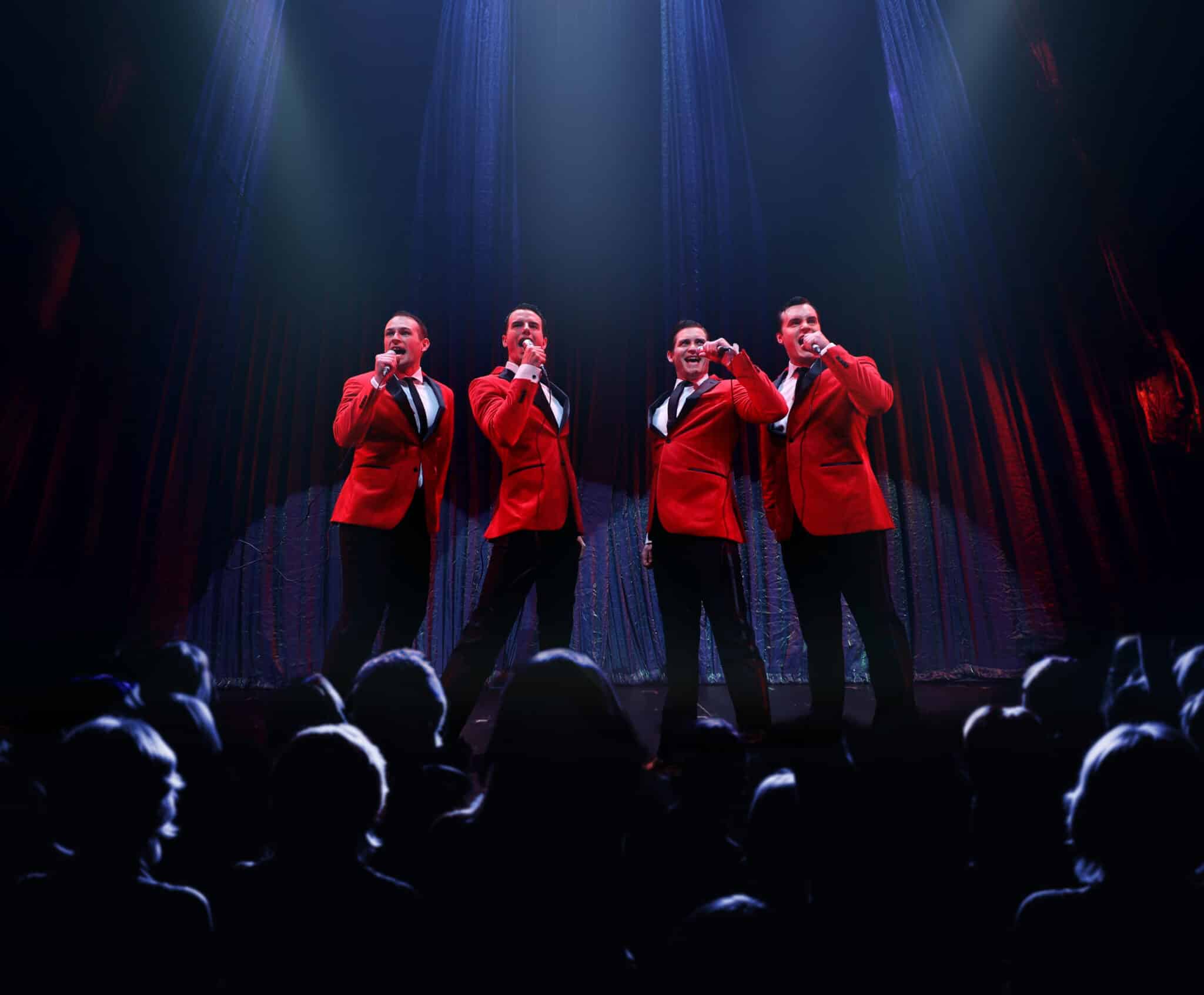
The megahit musical Jersey Boys makes its regional premiere in City Springs Theatre Company’s (CSTC) first-ever, five-week run at the Byers Theatre in Sandy Springs.
Directed by Atlanta’s-own Shane DeLancey, and choreographed by Meg Gillentine, Jersey Boys tells the rags-to-riches story of Frankie Valli and The Four Seasons. The show details their remarkable journey from the streets to the top of the charts, to their 1990 induction into the Rock and Roll Hall of Fame.
Leading the cast of Jersey Boys is Haden Rider as Frankie Valli. Rider is a City Springs Theatre Company veteran, with recent roles in both Legally Blonde (Emmett) and Fiddler on the Roof (Perchik).
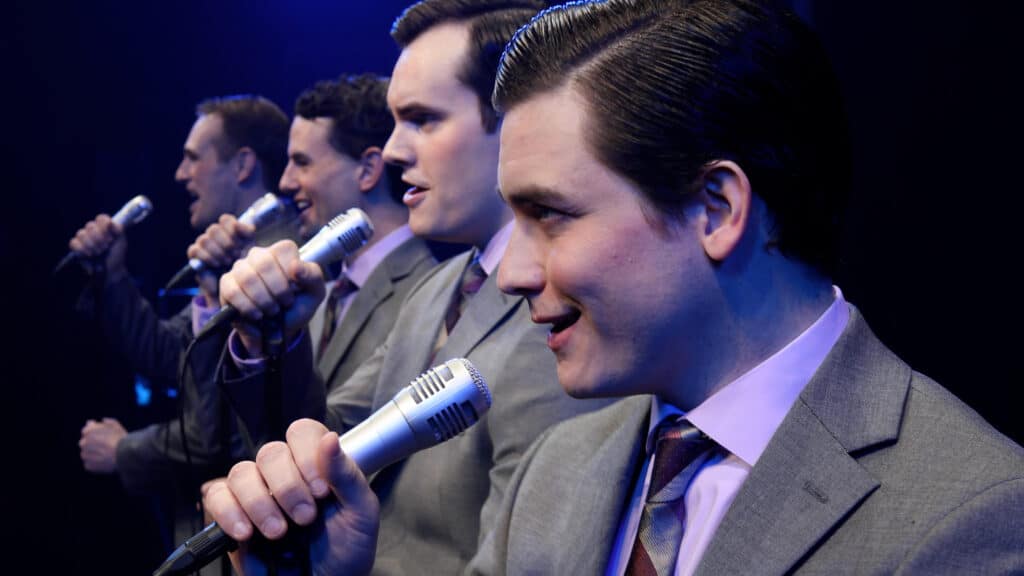
Presented by Resurgens Spine Center, Jersey Boys runs from July 12 through August 11, and shines a special spotlight on home-grown talent, as the show’s four leading men are all Atlanta-area residents.
With phenomenal music, memorable characters and great storytelling, Jersey Boys follows the fascinating evolution of four blue-collar kids who became one of the greatest successes in pop-music history.
“City Springs Theatre Company is very proud to be the first in the southeast region to present Jersey Boys,” said CSTC Artistic Director and Tony Award-winner Shuler Hensley. “Our audiences have been asking for this particular show since we opened. The production is truly stacked with talent onstage and off, and we’re pulling out all the stops to bring audiences an experience that will rival any previous version of the show.”
Jersey Boys premiered at the La Jolla Playhouse in 2005, prior to its 13-year Broadway run, from 2005 to 2017. There have been productions of the show in Las Vegas, UK/Ireland, Toronto, Melbourne, Singapore, South Africa, the Netherlands, Japan, Dubai and China.
Jersey Boys features a book by Marshall Brickman and Rick Elice, with music by Bob Gaudio, and lyrics by Bob Crewe.
Individual tickets to see Jersey Boys are on sale now ($42 – $108), with discounts for seniors, students, groups and active and retired military personnel.
CSTC’s Box Office is open Monday through Friday from 10:00 a.m. – 5:00 p.m.
Call 404-477-4365 or visit CitySpringsTheatre.com for more information.
This production contains adult language and is recommended for mature audiences.
Performance schedule:
Friday, July 12 | 8:00 p.m.
Saturday, July 13 | 2:00 p.m. & 8:00 p.m.
Sunday, July 14 | 2:00 p.m. & 7:30 p.m.
Tuesday, July 16 | 7:30 p.m.
Wednesday, July 17 | 7:30 p.m.
Thursday, July 18 | 8:00 p.m.
Friday, July 19 | 8:00 p.m.
Saturday, July 20 | 2:00 p.m. & 8:00 p.m.
Sunday, July 21 | 2:00 p.m. & 7:30 p.m.
Tuesday, July 23 | 7:30 p.m.
Wednesday, July 24 | 7:30 p.m.
Thursday, July 25 | 8:00 p.m.
Friday, July 26 | 8:00 p.m.
Saturday, July 27 | 2:00 p.m. & 8:00 p.m.
Sunday, July 28 | 2:00 p.m. & 7:30 p.m.
Tuesday, July 30 | 7:30 p.m.
Wednesday, July 31 | 7:30 p.m.
Thursday, August 1 | 8:00 p.m.
Friday, August 2 | 8:00 p.m.
Saturday, August 3 | 2:00 p.m. & 8:00 p.m.
Sunday, August 4 | 2:00 p.m. & 7:30 p.m.
Tuesday, August 6 | 7:30 p.m.
Wednesday, August 7 | 7:30 p.m.
Thursday, August 8 | 8:00 p.m.
Friday, August 9 | 8:00 p.m.
Saturday, August 10 | 2:00 p.m. & 8:00 p.m.
Sunday, August 11 | 2:00 p.m. & 7:30 p.m.
Related
Arts & Literature
Local Students Show Off Their Artistic Creations
Published
2 months agoon
June 2, 2024
From May 11 through May 18, the Norcross Gallery & Studios kicked off a fantastic exhibition, Reflections at Rectory, which showcased the works of 36 rising stars: AP and IB art students from our local high schools.
The opening reception celebrated their creativity and dedication. Gallery director Anne Hall presented a dozen awards generously sponsored by the community, a testament to the local support for these young artists.
One prestigious award, the Terri Enfield Memorial Award, holds special significance.
Established by Terri’s daughters, it recognizes not just artistic excellence, but also leadership, work ethic and the spirit of collaboration. Last year’s winner, Aidan Ventimiglia, even played a part in selecting this year’s recipient Jasmine Rodriguez.

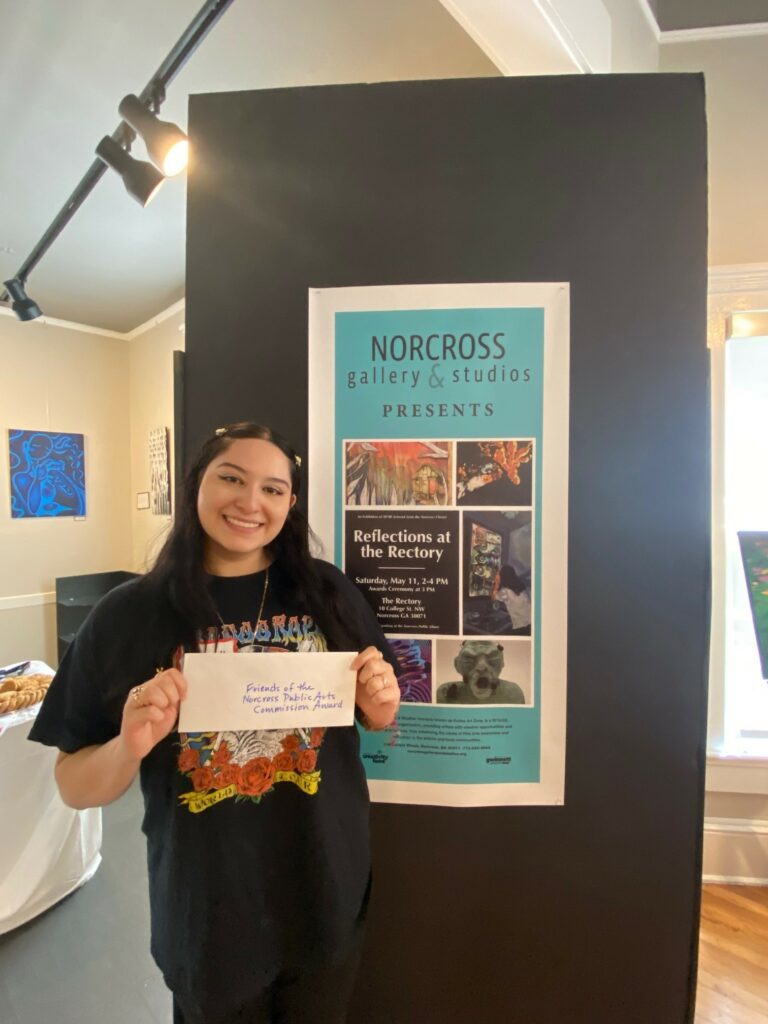
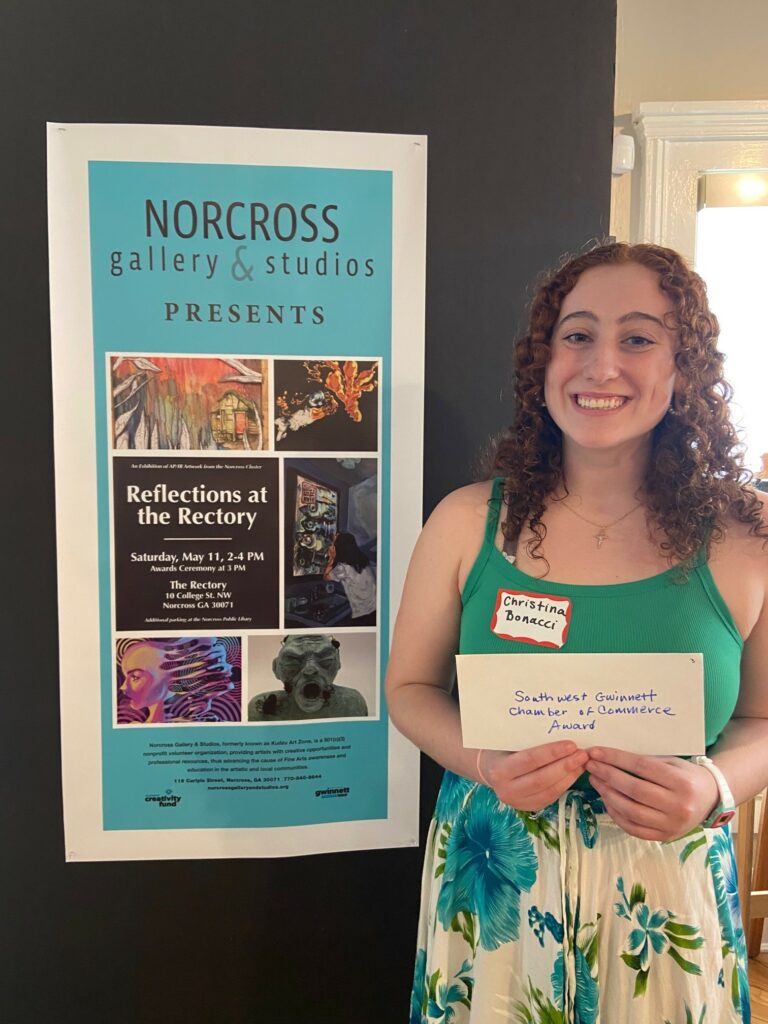
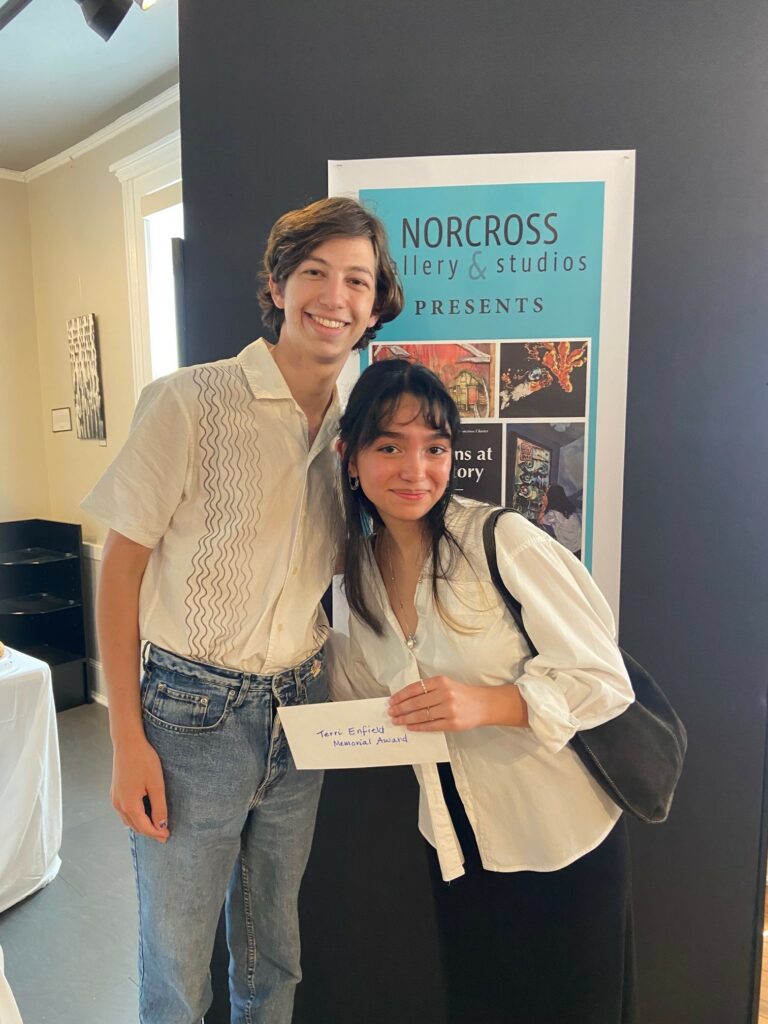
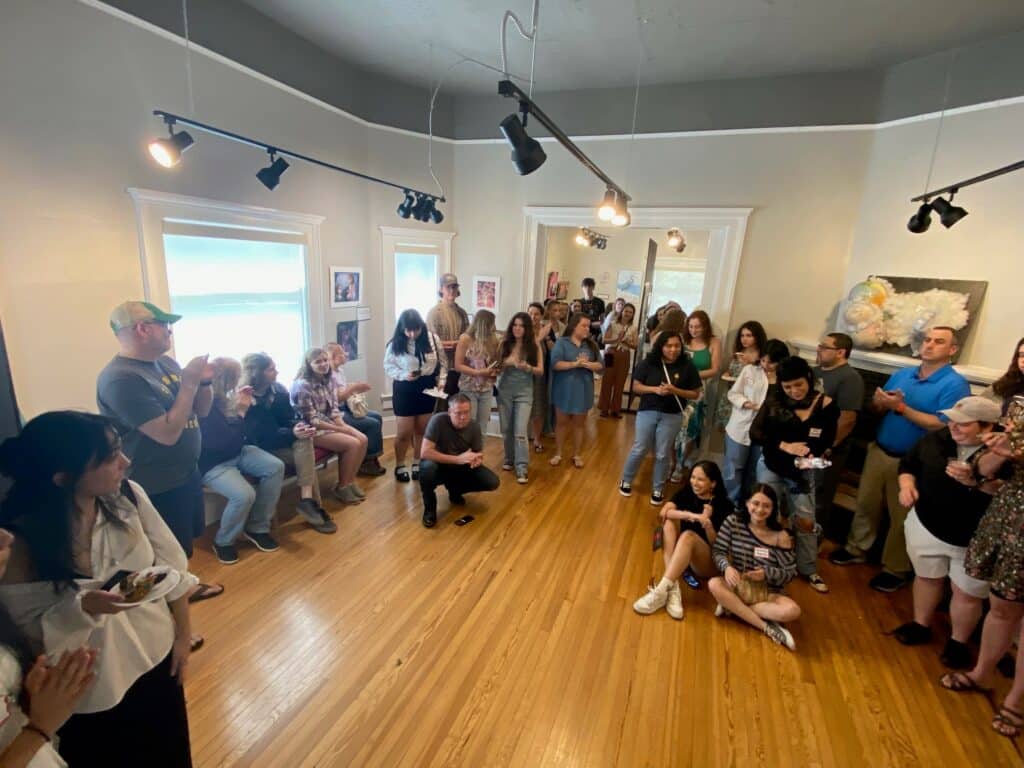
Congratulations to all the student artists.
Students in the second annual Reflections at the Rectory exhibit
Norcross High School:
- Gustavo Benumea-Sanchez
- Maycol Cruz Padilla
- Dorie Liu
- Harlet Martinez Castro
- Paulina Santana
- Gisela Rojas Medina
- Clare Fass
- Ava Netherton
- Ubaldo Diaz
- Katia Navas-Juarez
- Mariah Ingram
- Arisdelcy Juan
- Max Kaiser
- Dani Olaechea
- Christina Bonacci
- Diana Ortiz Ventura
- Katie Yerbabuena-Padierna
Paul Duke High School:
- Adamu Abdul-Latif
- Salma Noor Alabdouni
- Samrin Zaman
- Camryn Vinson
- Liz Damian
- Cecelia Berenguer
- Jasmine Rodriguez
- Angelina Bae
- Dahyana Perez
- Jonah Swerdlow
- Kyra Allicock
- Anni Brown
- Kaleb Fields
- Destiny Jones
- Gabriela Leal-Argueta
- Madisyn Mathis
- Ashley McDonough
- Ahtziri Pinones
- Alondra Valiente-Torres
Related
Arts & Literature
Book, TV and Podcast Recommendations for this Summer
Published
2 months agoon
June 2, 2024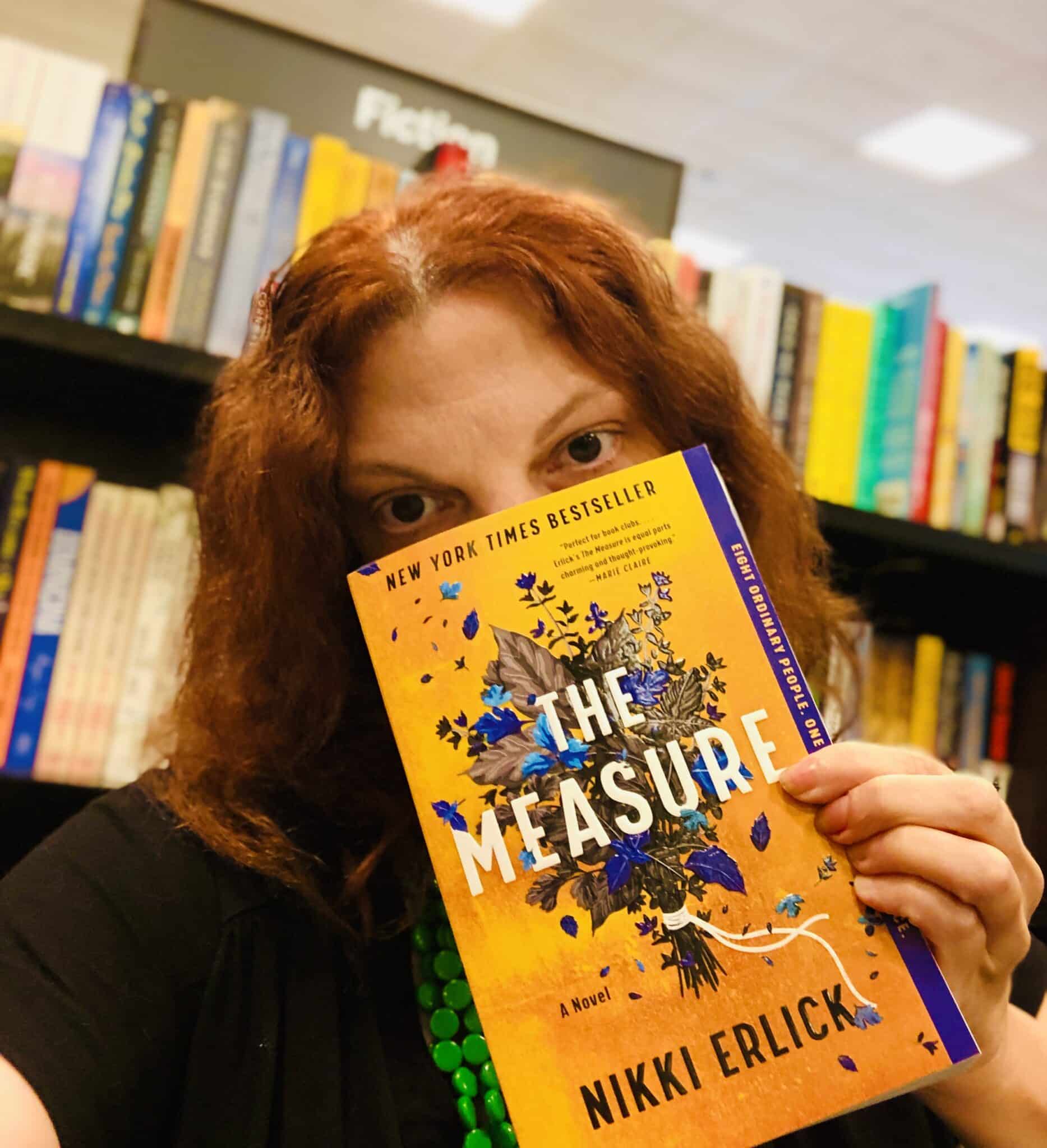
Beat the heat this Summer with a good book, show or podcast. This year, Peachtree Corners Magazine received over 30 recommendations from more than a dozen city residents. There is something for everyone on this list, so let’s dive in.
Machine Made: Tammany Hall and the Creation of Modern American Politics
by Terry Golway
This 400-page book offers readers a comprehensive and insightful exploration of one of the most influential political machines in American history. It provides valuable lessons and perspectives on the intersection of politics, power and society.
Turning Point: The Bomb and the Cold War
Stream on Netflix
This nine-part series offers viewers a thought-provoking exploration of one of the most consequential periods in modern history. It provides deep insights into the complexities of nuclear politics and the enduring legacy of the Cold War.
Fareed Zakaria GPS
Listen on CNN Audio
This podcast comprehensively examines foreign affairs. It enhances a listener’s global awareness, fosters critical thinking and sheds light on complex issues shaping our world today.
— Brian Johnson, City Manager for Peachtree Corners
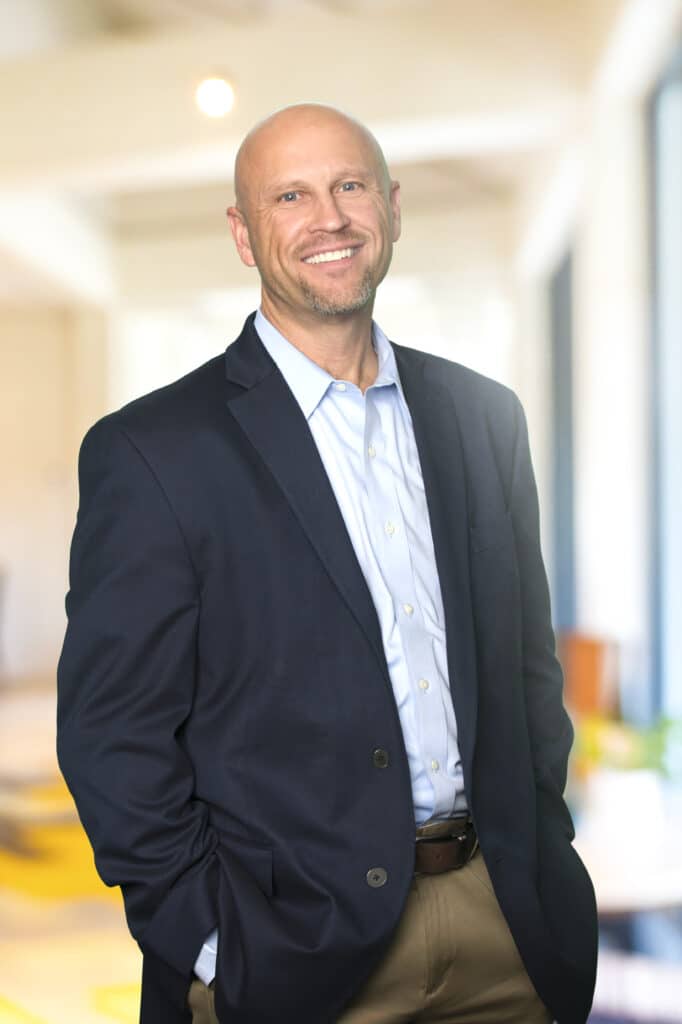
Empowering Nurses Through Self-care: Unleashing Your Potential and Thriving in the Nursing Profession
by Audrey Boyce
Audrey Boyce offers a practical guide to help nurses find balance and fulfillment in their personal lives and professions. With a comprehensive overview of self-care strategies, this book is essential for nurses looking to recharge, reduce stress and increase job satisfaction.
The Go-Giver, Expanded Edition: A Little Story About a Powerful Business Idea by Bob Burg and John David Mann
The Go-Giver tells the story of Joe, an ambitious young man striving for success. Through Joe’s journey, this book imparts powerful lessons about the significance of giving, collaboration and building meaningful relationships in achieving success.
Special Ops: Lioness
Stream on Paramount+
The protagonist, Joe, attempts to balance her personal and professional life as the tip of the CIA’s spear in the war on terror. The Lioness Program enlists Cruz to operate undercover alongside Joe among the power brokers of State terrorism.
Money and Wealth
Listen on Apple Podcasts
In Money and Wealth, John Hope Bryant provides valuable insights into financial literacy and wealth-building strategies. With a clear and accessible approach, Bryant aims to empower listeners with practical knowledge to achieve financial stability and success.
— Bobby Cobb, CEO of Cobb Global Outreach Inc.
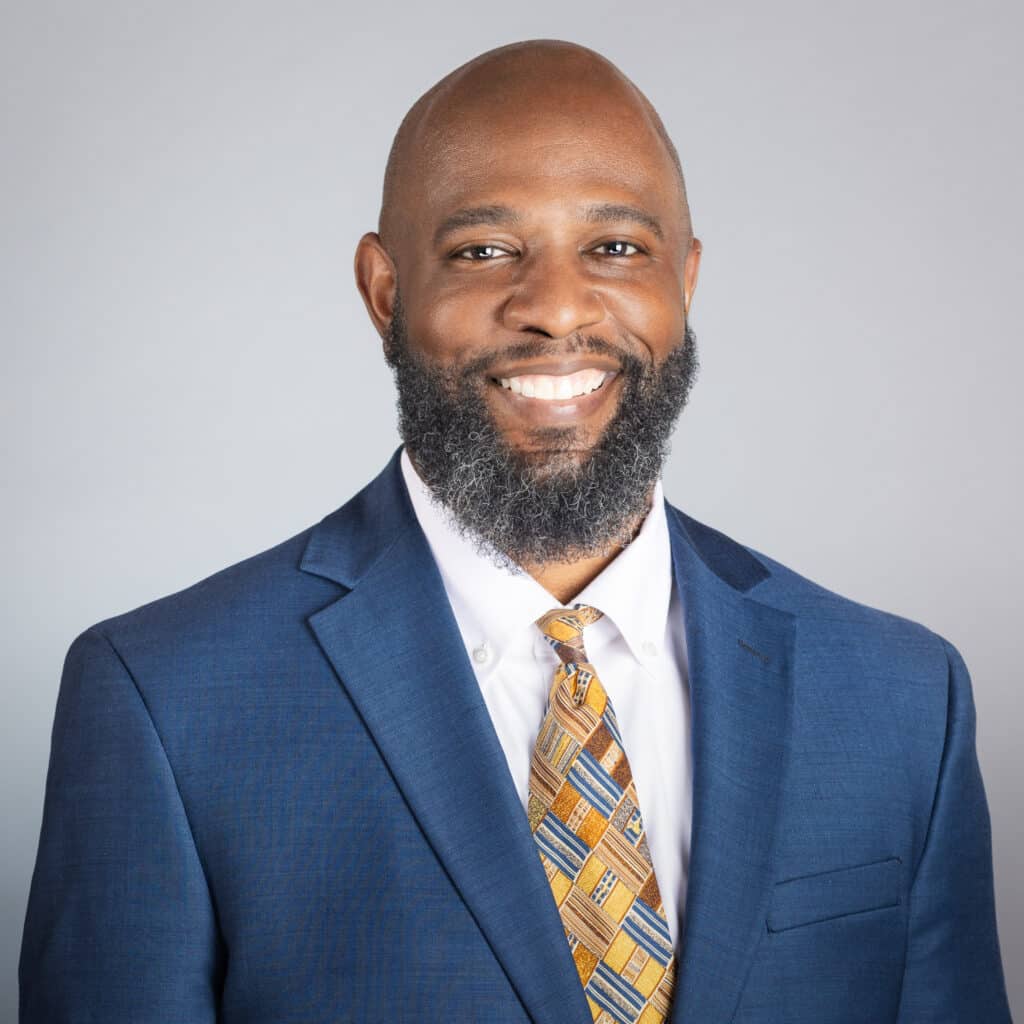
1984
by George Orwell
The new audio drama of George Orwell’s 1984 on Audible is nothing short of phenomenal. With a full cast of film stars and sound effects in stereo, you’ll feel like you’re actually in Oceania, being watched by Big Brother.
— Jill Tew, local author of the forthcoming young adult dystopian novel The Dividing Sky

Enter Ghost
by Isabella Hammad
I recently read this and loved the writing. The author plays around with formatting between narrating the story and switching to the format of a play to show the dynamics between characters.
— Ruwa Romman, Georgia State Representative
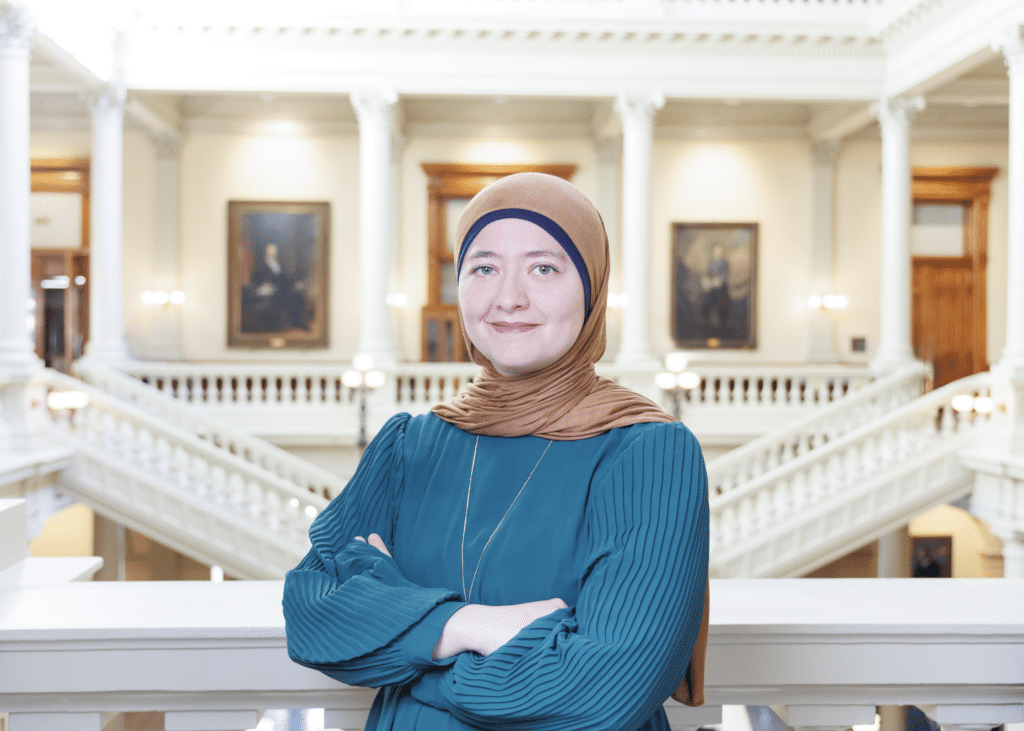
Seeing Eye Girl
by Beverly Armento
Beverly Armento’s account of her life in Seeing Eye Girl is truly remarkable. I was captivated by her story of resilience, strength and, ultimately, forgiveness.
— Erin Griffin, Norcross High School Foundation for Excellence Co-President
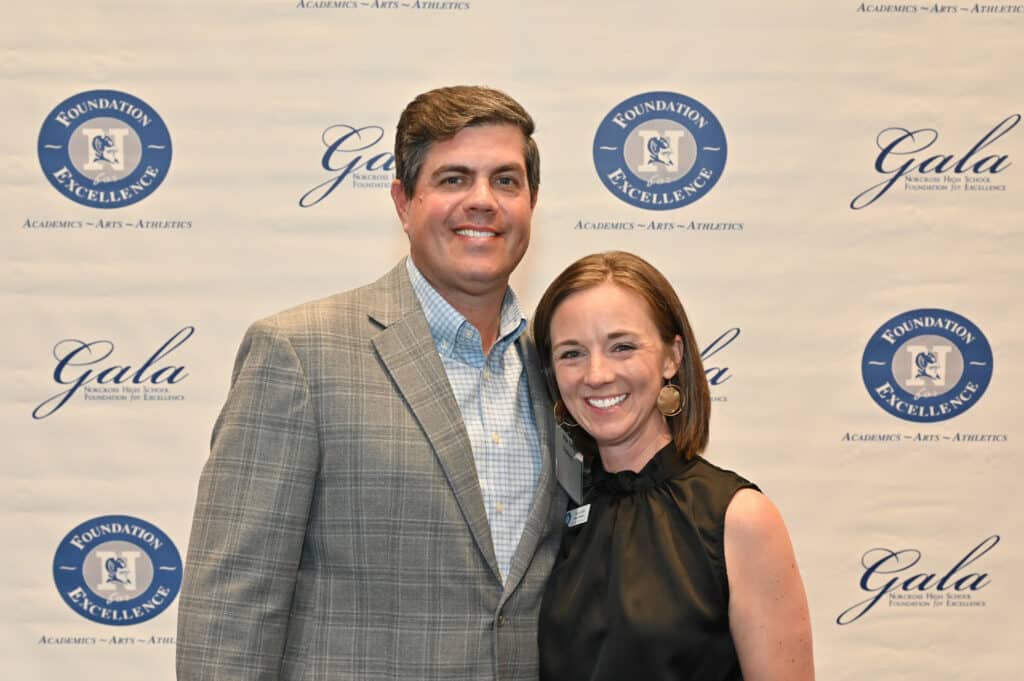
Never Enough: When Achievement Pressure Becomes Toxic – And What We Can Do About It
by Jennifer B. Wallace
This book presents research on how to raise healthy, joyful achievers in a hyper-competitive world. The author was a guest speaker at Greater Atlanta Christian’s (GAC) Parent Partnership Series this year, and we heard about the importance of children knowing that their intrinsic self-worth is not contingent solely upon external achievements.
The Anxious Generation
by Jonathan Haidt
Discover the root causes behind the epidemic of today’s teen mental illness. With compelling data, Jonathan Haidt unveils the decline of play-based childhood and offers practical solutions for a healthier, more fulfilling upbringing. We have asked GAC faculty to add this to their personal summer reading list.
— Dr. Scott Harsh, President of Greater Atlanta Christian School
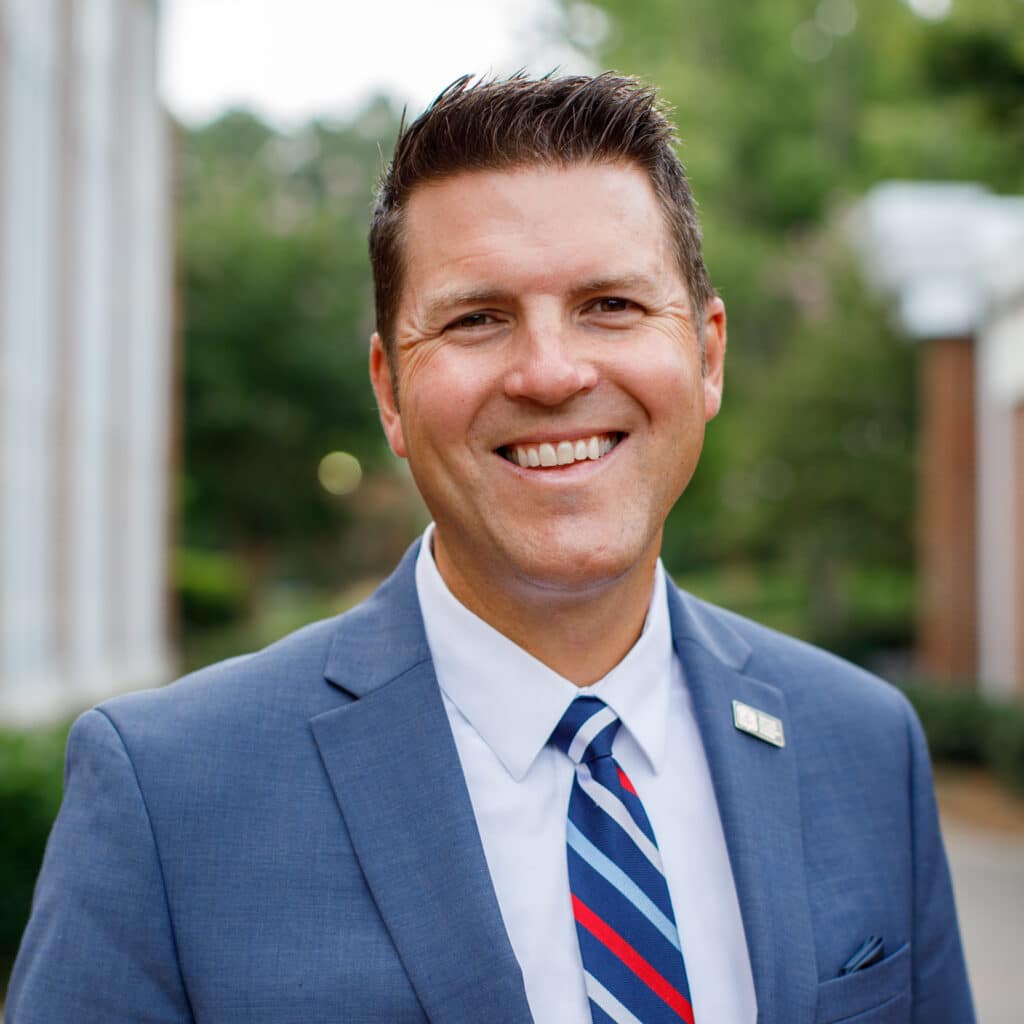
Glad You’re Here
by Craig Cooper and Walker Hayes
Glad You’re Here tells the true, redemptive story of country music singer Walker Hayes and his unlikely friendship with pastor Craig Cooper. In alternating chapters, each individual shares their unique perspective on pivotal moments in their friendship, and the book reminded me to prioritize the patient and persistent cultivation of community.
— Ann Cousins, Communications Director and Wesleyan School
The Boredom Experiment
Listen on Apple Podcasts
The Boredom Experiment, hosted by Jeremy and Ashley Parsons, is a short, heartfelt podcast series that documents and explores the effect of removing digital distractions and social media from their family’s lives for a year.
Over eight episodes, they share their experiences and insights into how this experiment impacts their creativity, relationships and overall well-being. The Parson’s storytelling thoughtfully weaves together interviews, music and their musings in such a creative, personal way that makes it an absolute delight to listen to.
The 1000 Hours Outside Podcast
Listen on Apple Podcasts, Spotify and Youtube
Digital Minimalism
by Cal Newport
Digital Minimalism advocates for a thoughtful and intentional approach to technology use. Newport argues that constant connectivity and digital distractions hinder productivity and well-being and encourages individuals to choose tools and habits that align with their values and long-term goals. In a digitally crowded world, this book was a needed reminder to be intentional with my time and strategic with how I use technology.
— Natalie Dettman, Creative Director at Wesleyan School
Sideline C.E.O.
by Marty Smith
While on this surface this book offers great wisdom from some of the most successful coaches of our time, it also provides a behind-the-scenes look at the lives of many people we admire.
From learning about Greg Sankey figuring out how to lead the SEC through Covid as he sat on his front porch to Mack Brown processing through how to lead his football team through racial tensions at UNC, you realize that these men [and women] are normal human beings that face the same difficult choices as the rest of us.
Not to mention, Marty Smith captures the lives and insight of these coaches in a fun, compelling way!
Practicing the Way
by John Mark Comer
New Kid
by Jerry Craft
Where Do We Go from Here
by Martin Luther King Jr.
— Joseph Antonio, Middle School Principal at Wesleyan School
West with Giraffes
by Linda Rutledge
This is lightly based on a true story. It is the story of moving giraffes who survived a hurricane, were rescued in the Atlantic, and were carried cross-country to the San Diego Zoo. It is well-written, and the character development is fantastic.
Crossing the country with two giraffes during the Depression created excitement in all the small struggling areas. The joy of those who had never dreamed of seeing a giraffe in real life will bring joy to anyone reading this book.
Housewives of True Crime
Listen on Apple Podcasts and Youtube
Moms and Mysteries
Listen on Apple Podcasts, iHeart Radio and Spotify
Southern Fried Crime
Listen on Apple Podcasts and Youtube
Wiser than Me with Julia Louis-Dreyfus
Listen wherever you get your podcasts
— Nancy Minor, The Nancy Minor Team
The Women
by Kristen Hannah.
A great read about the Army nurses in Vietnam.
— Laurie Rogers, The Nancy Minor Team
In The Woods
by Tana French
This book is a real page-turner. The author is a gifted writer, so even though it is a crime thriller, it reads like a novel. There are six books in the series, and I have read all of them.
Casefiles
Listen on Apple Podcasts and Spotify
This is a true crime podcast that has been around for several years. The stories are detailed and very interesting and cases are examined from all over the world.
— Shameka Allen, MBA, MA, CEO of Good Samaritan Health Centers of Gwinnett
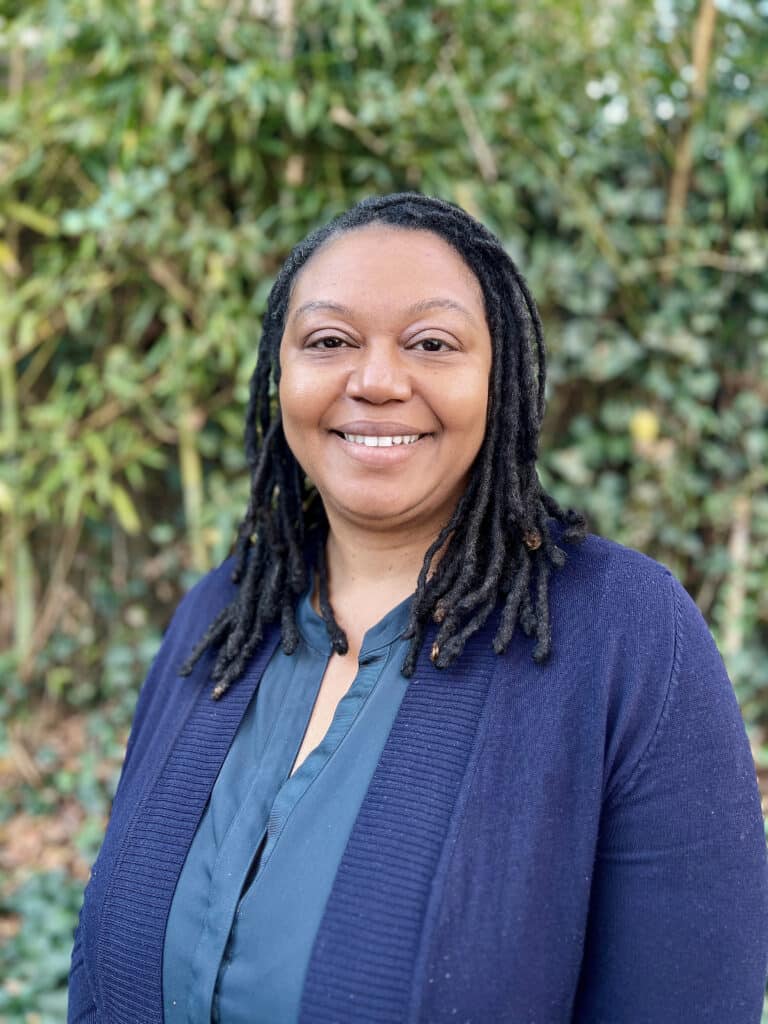
Over the Edge of the World
by Laurence Bergreen
Over the Edge of the World is a captivating account of Magellan’s expedition around the world. We all know Magellan’s name but few of us know the rich details behind the adventure and how it unfolded. I was inspired by the courage and bravery of those who took part in the great Age of Exploration.
Arrested Development
Stream on Netflix
This is easily one of our favorite shows. My wife, Meredith, and I have watched and re-watched it so many times and still find it so hilariously funny. The show blends clever writing with quirky characters and intricate, running gags. There’s always money in the Banana Stand!
Dr. Death
Listen on Apple Podcasts, Spotify and Wondery
This gripping true-crime podcast explores the shocking story of a dangerous surgeon. It’s a must-listen for its compelling narrative, deep investigative journalism and critical insights into medical malpractice and systemic failures. The podcast has since been made into a limited streaming TV series.
— Scott Hilton, Georgia State Representative
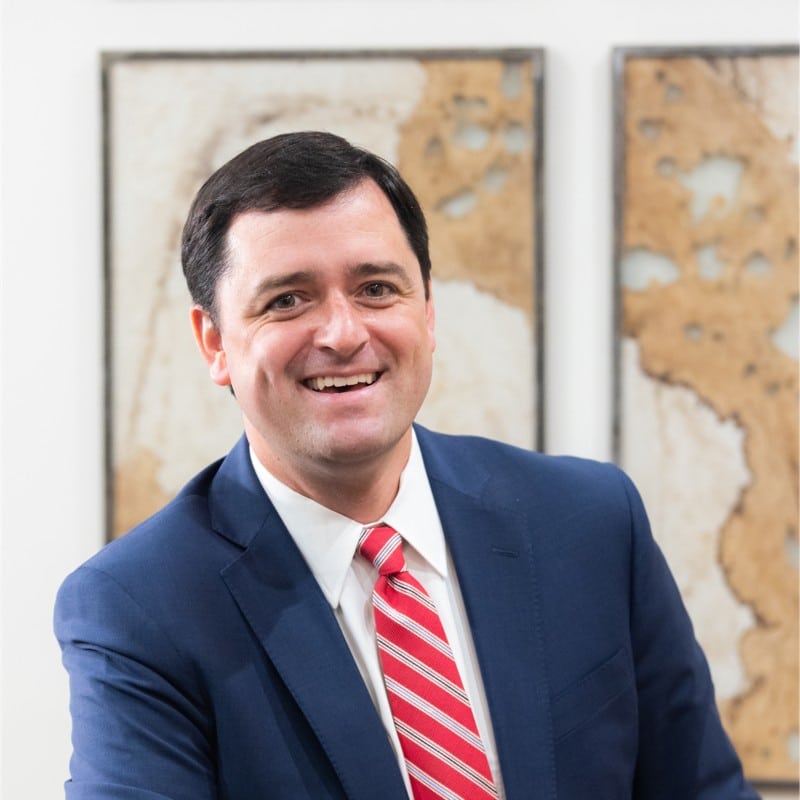
Sleep Wrecked Kids
by Sharon Moore
This book explains how inadequate sleep affects children’s growth, development and learning. This is a great guide to creating better sleep routines.
Healthy Sleep Happy Kid
by Meghna Dassani
This quick, easy read offers valuable insights into how sleep impacts a child’s health. It provides practical tips for improving your child’s sleep environment and habits and is a go-to resource for parents aiming to enhance their child’s sleep and overall wellness.
I can’t overstate the importance of good sleep habits for the overall well-being of your child and the entire household. Quality sleep is the foundation for happy, healthy kids and stress-free parents, setting the stage for the best possible summer with your family.
— Dr. Gia Grannum, Board Certified Pediatric Dentist of Agape Pediatric Dentistry
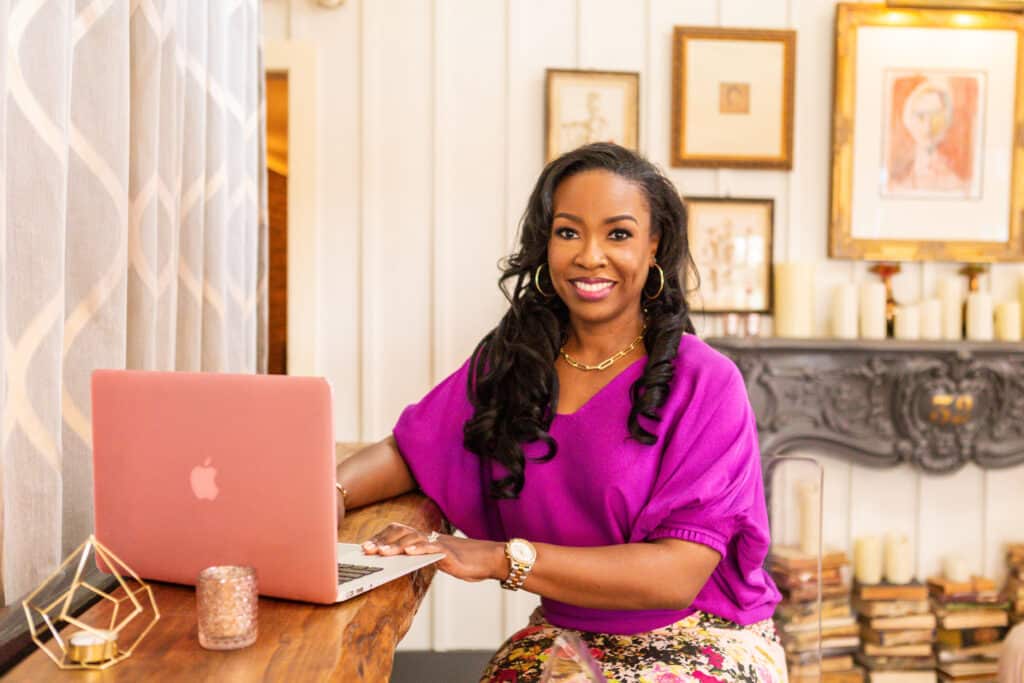
The Measure
by Nikki Erlick
I recommend The Measure by Nikki Erlick, which is about to come out in paperback! It’s a great pick for summer reading or a book club!
Poured Over, the Barnes & Noble Podcast
Stream on the Barnes & Noble website and Apple Podcasts
Check out the Poured Over podcast for interviews with your favorite authors, book recommendations for your TBR pile and more.
— Amanda Couch, Assistant Manager at Barnes & Noble at The Forum
Want even more recommendations? Check out last year’s list here.
Related
Read the Digital Edition
Subscribe
Keep Up With Peachtree Corners News
Join our mailing list to receive the latest news and updates from our team.
You have Successfully Subscribed!

What’s going on at Jones Bridge Park and the Challenges of Urban Development

Taste of Peachtree Corners: PCBA Showcases Local Restaurants

The Forum Gives Sneak Peek of New Eateries and Community Spaces

Southwest Gwinnett Mayors Share Visions for the Future

8 Events Happening In and Around Peachtree Corners This August

Peachtree Corners Shines Bright with Light Up the Corners Glow Race this August

Peachtree Corners Shines Bright with Light Up the Corners Glow Race this August

The Forum Gives Sneak Peek of New Eateries and Community Spaces

8 Events Happening In and Around Peachtree Corners This August

Southwest Gwinnett Mayors Share Visions for the Future

Taste of Peachtree Corners: PCBA Showcases Local Restaurants

What’s going on at Jones Bridge Park and the Challenges of Urban Development

Local Resident Opens AtWork Location in Peachtree Corners

CHRIS 180 Expands its Services into Gwinnett County [Podcast]

Light up the Corners [Video]

Capitalist Sage: Business Leadership in Your Community [Podcast]

Cliff Bramble: A Culinary Adventure through Italy

Top 10 Brunch Places in Gwinnett County

A Hunger for Hospitality

THE CORNERS EPISODE 3 – BLAXICAN PART 1

Top 10 Indoor Things To Do This Winter

The ED Hour: What it takes to Remove Barriers from Education
Peachtree Corners Life
Topics and Categories
Trending
-
Business1 week ago
Taste of Peachtree Corners: PCBA Showcases Local Restaurants
-
Business2 days ago
The Forum Gives Sneak Peek of New Eateries and Community Spaces
-
City Government4 days ago
Southwest Gwinnett Mayors Share Visions for the Future
-
Around Atlanta4 days ago
8 Events Happening In and Around Peachtree Corners This August



